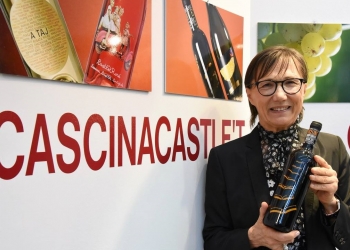Uvalino will be starring in a tasting dedicated to rare wines at vinitaly 2017
Thursday 6 April 2017
Uvalino, an almost disappeared Piedmontese grape variety, will be starring in a tasting of rare wines at Vinitaly 2017, on Sunday 9th April at 3.00 pm, in front of an audience of buyers, journalists, masters of wine and master sommeliers from all over the world. It is an initiative of the National Association Le Donne del Vino, that entrusted one of the world’s foremost experts of Italian native grapes, the journalist Ian D’Agata, with the task of communicating the importance of women winemakers in preserving ancient varieties that would otherwise be lost.
Many other grapes share the same history as Uvalino, an extremely rare variety from Piedmont once very widespread in the Asti area vineyards. It has been rediscovered by Mariuccia Borio, Donna del Vino and winegrower of Cascina Castlèt in Costigliole d’Asti, the lands where Marquis Filippo Asinari, a farsighted winegrower, was the first to make important wine experiments in the XIX century.
For 27 years Maria Borio has believed and financed the University research aimed at preserving and promoting the cultivation of Uvalino on the hills of Costigliole.
“Uvalino has always been part of my life – says Mariuccia. After a withering period, Uvalino was either used to improve the quality of other wines, or made into a single varietal wine, in which case it was the wine for special occasions such as weddings and baptisms, or it was a present for the doctor, the chemist or the parish priest”. She remembers: “In the 80’s I was discussing about Uvalino with the Barolo producer Renato Ratti, who had planted a little vineyard – that now doesn’t exist anymore – right opposite Cascina Castlèt, at Villa Pattono. In 1990 I started to think about this research”.
The first researches in the vineyard started with Professor Lorenzo Corino, former director of the Viticulture Institute in Asti. After, the first microvinification experiments with the oenologist Armando Cordero, that were continued by Giorgio Gozzelino, who tested different vinification techniques. We then started gathering the memories of elder winegrowers, and in 1992 we planted the first grapevine row. Today we have around one and a half hectares of Uvalino in two vineyards, both at 280 meters above sea level and trained by the guyot system.
This research has been an important investment on the economic side, but most of all in terms of credibility. Since vintage 1995, the Experimental Institute for Oenology in Asti, then led by Professor Rocco Di Stefano, has also been our partner. The researcher Daniela Borsa supervised the studies at the Institute, and in 2003 she presented the project at the VII International Symposium of Oenology in Arcachon, organized by the University of Bordeaux, where the most important European wine researches are presented.
The bureaucratic procedures that led Uvalino to be a recognized and authorized grape variety lasted some years, and were carried on with the cooperation of the Department of Agriculture of Regione Piemonte, and the department manager Ettore Ponzo. On 16th July 2002 the Italian Official Journal established the rebirth of Uvalino, that was listed as a recognized variety: a winning challenge, at last.
A scientific curiosity: Uvalino has an extremely high content of Resveratrol, an antioxidant substance whose concentration is 30/40 times higher than in other red wines. The beneficial effects of Resveratrol on human health were also explored by Professor Aldo Bertelli and the Institute of Pharmacology in Milan.
The first marketed vintage was 2006, issued in 2009. Today we make around 5.000 bottles of Uvalino, and it is a wine that is better appreciated after some years of ageing. During the harvest, Uvalino grapes are put into small baskets, and then withered for a varying period. The vinification process requires three weeks of long maceration, and after the malolactic fermentation, the wine matures for 12 months in 500-litre tonneaux. After the bottling, the wine ages one more year before being put on the market.
The wine Cascina Castlèt makes with Uvalino grapes is named Uceline. This name was not randomly picked, as oenologist Gianluigi Bera found out in his historic research: in the early XVII century it was used in the Turin and Asti areas for very late-ripening grapes, which were harvested when the vines had already lost all their leaves, so much so that they were in large part eaten by birds (in Italian “uccelli”).
At Vinitaly 2016 a new label was presented, where the letters contained in “Uceline” come to life by simulating the flight of a small flock of birds. It is an idea by Giacomo Bersanetti from Sga Wine Design, who signed all the graphics and labels of this winery.
Infos: www.cascinacastlet.com

